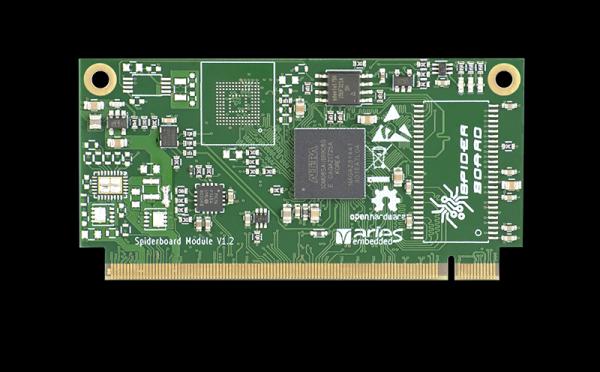MX10 and SpiderSoM modules are outfitted with a USB device interface, applied with PIC16F1454 microcontroller (MCU). On the SoM side the MCU is connected to three interfaces: serial (if the other side is applied inside the FPGA), an I2C bus (connected to the module PMIC, charge controller, RTC and FPGA), and FPGA JTAG programming interface. The 70mm x 35mm modules support Linux Operating System, but currently, Ubuntu16.04LTS is marked as a reference base.
The modules feature a programmable clock generator and PLL, with optional external reference input. Available also are 178 FPGA GPIO pins, including 13 LVDS transmitters and 54 receivers. optional 128/256/512MByte DDR3 DRAM (for 10M 16/25/40/50 FPGAs) is also available. Programmable high-efficient PMIC, FPGA IO voltages are configurable for user convenience. The modules support a wide range of devices: from 10M04DC to 10M50DA. Other features include an optional Li-Ion/Li-Pol charger, RTC with battery backup, optional 4 GByte e.MMC, optional 4 MByte SPI NOR, optional 8 MiB SDRAM, and a MAX 10 FPGA in F256 package. The SpiderSoM is a programmable, non-volatile solution based on Intel®️ MAX®️10 FPGA, which allows it to produce full-featured FPGA capabilities.
The SpiderSoM can function with the standard baseboard (SpiderBase) as a total building block or can be plugged into an existing design and products as a functional part. It links to its baseboard via a 230pins MXM2 connector and gives the proper results for various soft-core CPUs, video-processing algorithms, etc. The SpiderSoM is a low cost and highly flexible platform which allows users to set up a running system according to the required specification in a very short time frame. SoM is modeled on the free and open design concept: KiCAD design files and schematics are available under CERN OHL v1.2. The MX10 SoM targets the aspect of professional electronic designs in commercial applications, while the SpiderSoM, on the other hand, was designed to be used in IoT Maker applications.
Read more: USB FOR INTEL’S MX10 AND SPIDERSOM MODULES

